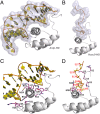Structural basis for homeodomain recognition by the cell-cycle regulator Geminin
- PMID: 22615398
- PMCID: PMC3384217
- DOI: 10.1073/pnas.1200874109
Structural basis for homeodomain recognition by the cell-cycle regulator Geminin
Abstract
Homeodomain-containing transcription factors play a fundamental role in the regulation of numerous developmental and cellular processes. Their multiple regulatory functions are accomplished through context-dependent inputs of target DNA sequences and collaborating protein partners. Previous studies have well established the sequence-specific DNA binding to homeodomains; however, little is known about how protein partners regulate their functions through targeting homeodomains. Here we report the solution structure of the Hox homeodomain in complex with the cell-cycle regulator, Geminin, which inhibits Hox transcriptional activity and enrolls Hox in cell proliferative control. Side-chain carboxylates of glutamates and aspartates in the C terminus of Geminin generate an overall charge pattern resembling the DNA phosphate backbone. These residues provide electrostatic interactions with homeodomain, which combine with the van der Waals contacts to form the stereospecific complex. We further showed that the interaction with Geminin is homeodomain subclass-selective and Hox paralog-specific, which relies on the stapling role of residues R43 and M54 in helix III and the basic amino acid cluster in the N terminus. Interestingly, we found that the C-terminal residue Ser184 of Geminin could be phosphorylated by Casein kinase II, resulting in the enhanced binding to Hox and more potent inhibitory effect on Hox transcriptional activity, indicating an additional layer of regulation. This structure provides insight into the molecular mechanism underlying homeodomain-protein recognition and may serve as a paradigm for interactions between homeodomains and DNA-competitive peptide inhibitors.
Conflict of interest statement
The authors declare no conflict of interest.
Figures





References
-
- Gehring WJ. Homeo boxes in the study of development. Science. 1987;236:1245–1252. - PubMed
-
- Gehring WJ, Affolter M, Bürglin T. Homeodomain proteins. Annu Rev Biochem. 1994;63:487–526. - PubMed
-
- Krumlauf R. Hox genes in vertebrate development. Cell. 1994;78:191–201. - PubMed
-
- Wellik DM. Hox genes and vertebrate axial pattern. Curr Top Dev Biol. 2009;88:257–278. - PubMed
Publication types
MeSH terms
Substances
Associated data
- Actions
LinkOut - more resources
Full Text Sources
Molecular Biology Databases
Research Materials

